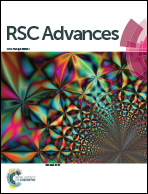Optimization of a minimal synergistic enzyme system for hydrolysis of raw cassava pulp†
Abstract
Cassava pulp is an underused agricultural by-product comprising residual starch granules entrapped in cell wall polysaccharides, making it unique from other lignocellulosic wastes in terms of enzymatic processing. In this study, a synergistic system comprising a minimal set of enzymes tailor-made for efficient bioprocessing of raw cassava pulp was developed. The fiber-degrading enzyme mixture comprises an endoglucanase (Cel12), β-glucosidase (BGL), endo-β-1,4-xylanase (XYN) and endo-polygalacturonase (EPG) from Aspergillus aculeatus and a cellobiohydrolase I (Cel7A) from Talaromyces cellulolyticus was initially optimized using the experimental design approach. A glucose recovery yield of 91.3% based on the total starch and cellulose content was obtained from saccharification of cassava pulp using the combination of 5.0 mg g−1 of fiber degrading enzyme mixture comprising Cel12, Cel7A, BGL, XYN and EPG in the ratio of 16.5 : 25.5 : 15.0 : 18.0 : 25.0 together with 0.5 mg g−1 of raw starch degrading enzyme Stargen™ 002 with the degree of synergy of 1.43. Efficient hydrolysis was achieved without an energy-intensive pretreatment step, showing industrial applicability on saccharification and modification of cassava pulp and for further incorporation of these enzymes into ethanologens for consolidated bioprocessing.



 Please wait while we load your content...
Please wait while we load your content...